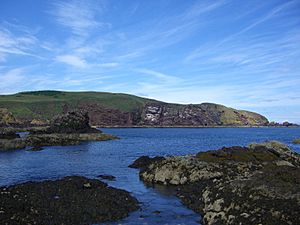National nature reserve (Scotland) facts for kids
Scotland's National Nature Reserves (NNRs) are special areas of land or water. They are chosen because they have important habitats and amazing wildlife. These places are protected by law to keep nature safe. NNRs can be owned by different groups, like public bodies, private owners, or community groups. But they all must be managed to protect their unique plants and animals. They also need to offer ways for people to enjoy and learn about nature.
Currently, there are 43 NNRs across Scotland. They cover a huge area, about 154,250 hectares (which is 1,542.5 square kilometres). This is less than 1.5% of Scotland's total land! These reserves vary a lot in size. For example, Corrieshalloch Gorge is quite small at 7 hectares. But Mar Lodge Estate is enormous, covering 29,324 hectares.
Being an NNR is a big honour for a nature reserve in Scotland. These sites show off Scotland's best nature. They are managed carefully for wildlife. They also have things like visitor centres and walking trails. This helps people explore and understand the habitats and animals living there. Many NNRs, like Glen Affric and Abernethy Forest, are also recognised internationally as protected areas. This shows how important they are for nature worldwide.
Most NNRs in Scotland are also known as Sites of Special Scientific Interest. Many are also part of a bigger European network called Natura 2000. This network includes Special Protection Areas (for birds) and Special Areas of Conservation (for habitats). Some NNRs are even Ramsar sites, which means they are wetlands of international importance.
How Did NNRs Start?
National Nature Reserves were first created a long time ago, in 1949. This was under a law called the National Parks and Access to the Countryside Act 1949. Later, in 1996, the main organisation for Scotland's nature, Scottish Natural Heritage (now called NatureScot), looked at the NNR rules again. They wanted to make sure NNRs were still the best way to protect nature.
They decided that NNRs should have four key things:
- Nature First: Protecting nature must be the most important thing happening on the land.
- National Importance: The plants, animals, or habitats must be so special that it's important for the whole country to protect them.
- Best Management: NNRs must be looked after really well, using the best methods.
- Long-Term Care: The plan for managing the reserve needs to be for a very long time, not just a few years.
NNRs also need to help with at least one of these three goals:
- Teaching People: Helping the public learn about nature.
- Special Care: Using special and active ways to manage the land.
- Research: Offering places for scientists to study nature and how to manage it.
Between 2000 and 2003, all the existing NNRs were checked against these new rules. Before 2004, Scotland had 73 NNRs. Some of these have since changed their status, but new ones have also been added. For example, Glen Coe and Mar Lodge Estate became NNRs in 2017.
Since 2012, different groups work together to decide on NNRs in Scotland. This group includes people from organisations that manage reserves and local community groups. NatureScot leads this group and is still in charge of officially declaring new NNRs.
Who Looks After NNRs?
NatureScot is the main organisation responsible for NNRs in Scotland. They decide which areas become NNRs. They also make sure each reserve is looked after properly. Most NNRs are managed directly by NatureScot. However, some are managed by other groups, or in partnership with them.
There are nine main groups that work together to manage NNRs. They are:
- Community Land Scotland
- Forestry and Land Scotland (FLS)
- National Trust for Scotland (NTS)
- RSPB Scotland
- Scottish Land and Estates
- NatureScot
- Scottish Wildlife Trust (SWT)
- South Lanarkshire Council
- Woodland Trust Scotland
Each NNR has a specific management plan to protect its unique features.
List of Scotland's National Nature Reserves
Here is a list of the National Nature Reserves in Scotland. It shows where they are and who helps manage them.
|



